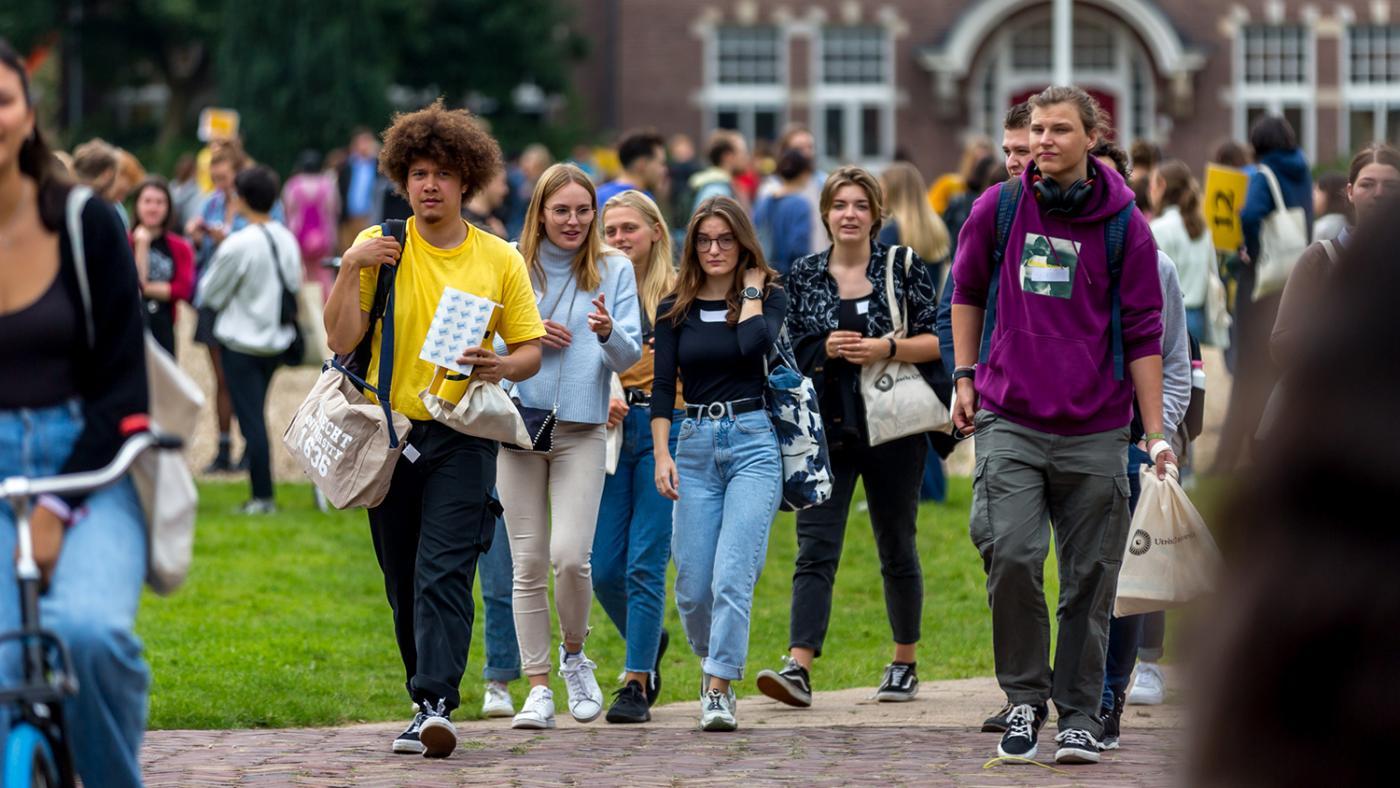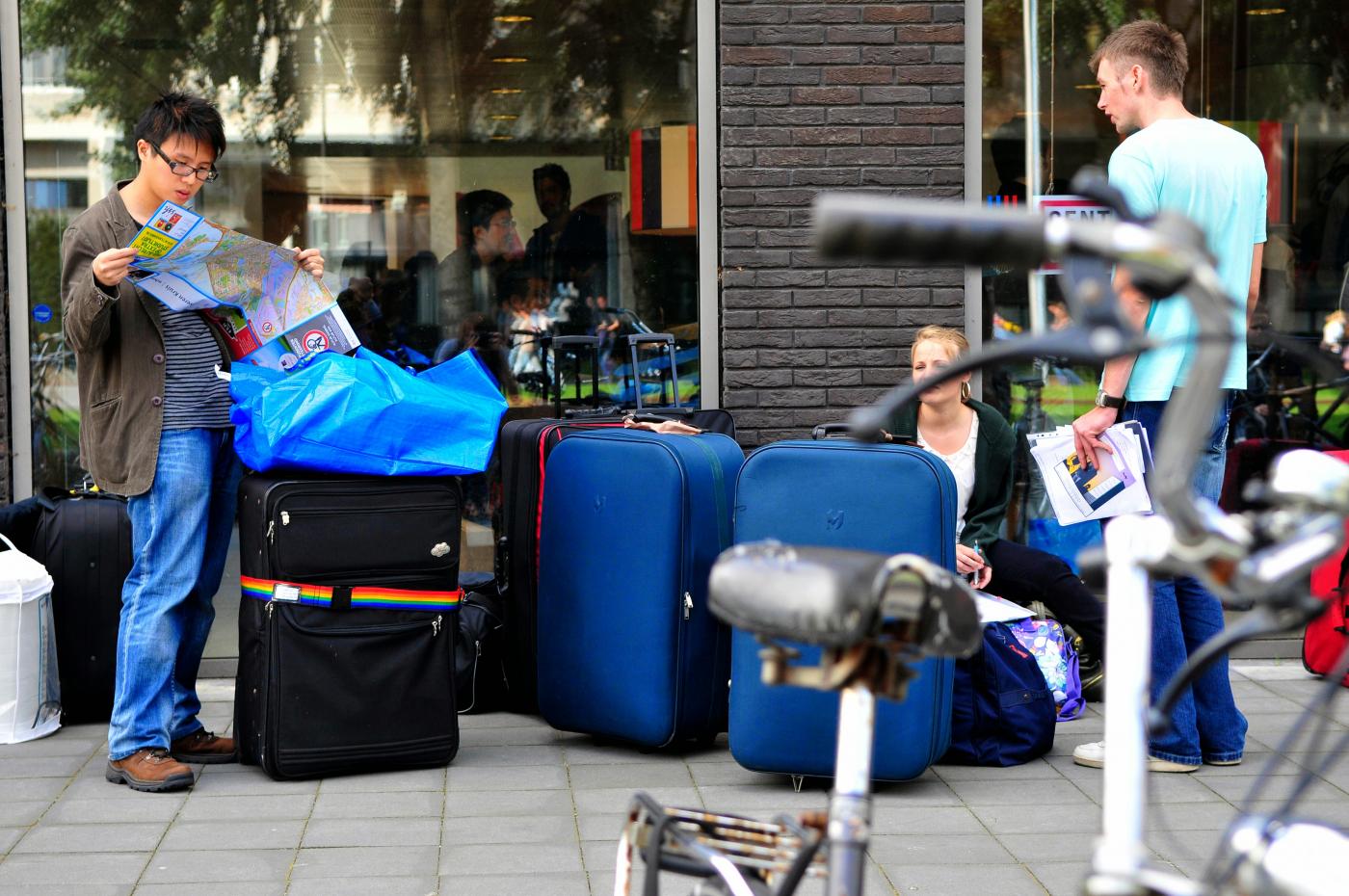‘What does Dutch society need?’
How the Netherlands became so popular among international students

Did you know that, of all the countries in continental Europe, the Netherlands is the one with the highest offer of English-taught higher education degrees? No wonder the number of international students increased significantly over the past decade. This academic year, more than 85,000 international students are attending research universities such as UU. That’s 7.3 percent more than last year. This means that one in four students registered at Dutch research universities is from abroad.
The international student community has been swelling at UU as well: the proportion of international registrations went from 9 percent in 2018 to 14 percent in 2022. This academic year, the university welcomed 2,759 first-year students from abroad. That’s 6 percent more than the year before. However, with 5,531 students from abroad, Utrecht is far from being among the Dutch universities with the highest number of international students. This list is led by the University of Amsterdam, Maastricht University, and the University of Groningen. In terms of proportion, Maastricht is the leader, with 59 percent of its student body coming from abroad.
Such an expressive number of people arriving from other countries, along with a steady rise in the number of Dutch nationals pursuing higher education degrees, does not come without consequences. In a country whose housing market is already under pressure, finding a room has become a strenuous affair. Many universities (UU included) are having to deal with a lack of lecture halls. And what about the future position of Dutch as an academic language? Is the use of English coming to the detriment of Dutch, as some say? The Dutch Minister of Education, Robbert Dijkgraaf, has just unveiled a long-awaited letter addressing these and other issues.
His main proposal is to set up a form of “central management” to control the influx of students based on societal considerations. For example, students would apply to study Medicine but they would not get to choose the institution, which would allow universities to alleviate the pressure on the biggest cities. It is not clear what this “central management” is going to look like, however. Dijkgraaf’s letter also allows universities to set up “emergency” enrolment limits to certain tracks. Another important proposal is that all international students should learn Dutch to increase their integration into society and improve their chances on the Dutch labour market later on.

One of the main problems for internationals is finding a room. Photo: DUB
A bit of history
To understand the minister’s proposals, it’s useful to take a deeper look at how the Netherlands became such a powerhouse of English-taught programmes.
It all started in 1999, with the Bologna Process, when all EU countries agreed to standardise higher education structures to make it easier for EU citizens to pursue degrees in fellow member states. This included the adoption of the Bachelor’s - Master’s - Doctorate system. Until then, there was an undergraduate level, followed by a doctorate.
“At the time, the vast majority of programmes were in Dutch. They switched to English to accommodate international students. That’s how universities decided that most Master’s tracks would be in English,” explains Patience Gondwe, Policy Advisor on International Education. Prior to this role, she worked for 11 years as a strategic policy advisor at Nuffic, the Dutch organisation for internationalisation in education.
As the 2000s went by, the transition to English was eagerly embraced by the Dutch Ministry of Education, which sets the framework for universities to follow. “The main reasoning was that it increases the quality of education and contributes to students’ personal development”, says Bart van de Laar, Programme Leader of International Affairs. “International students bring different perspectives, they ask different questions. They also tend to be highly motivated.”
In addition, universities wanted to prepare students for a labour market that was getting more and more globalised, with English as its lingua franca. In the year 2000, Statistics Netherlands forecasted the following decade to see some 130,000 immigrants arrive in the Netherlands each year, many of those for work purposes. Today, about 52 percent of those living in the four biggest Dutch cities have a first, second, or third-generation background. In addition, multiple multinational companies chose to open offices in the Netherlands as a gateway to Europe. In 2020, a record number of international companies did so. Van de Laar: “The world is international. Not for 100 percent of our graduates but, for the majority, it is.”
But that wasn’t the only incentive for universities to attract international students. In the Netherlands, the government allocates a budget for higher education, which is shared among institutions depending on the number of students they have. Basically, the more students you have, the biggest your share of the pie. Recruiting students from abroad made it possible for small programmes and institutions outside Randstad (the biggest conurbation in the Netherlands, which houses almost half of the country’s population) to keep existing, although those inside Randstad were actively recruiting foreigners as well.
UU’s Head of Marketing, Jessica Winters, who has been working with internationalisation since the mid-2000s, recollects that the goal used to be attracting as many international students as possible. “The Netherlands wasn’t very visible to international students in the past and we worked really hard to get the country on the map. Not just us, but everyone who was involved in international recruitment.” Needless to say, their efforts bore fruit. In twenty years, the Netherlands has become an attractive study destination thanks to a wide offer of English-taught courses, the quality of its institutions (there are currently nine Dutch universities in the top 200 of the Shanghai Ranking) and low tuition fees compared to American and British universities.

Photo: DUB
Today, 72 percent of international students in the Netherlands come from other countries in the European Economic Area, which goes to show how successful the Bologna Process was. According to Nuffic’s latest report, Germany is by far the most important country of origin, followed by Italy and Romania. At UU, Europeans form approximately 75 percent of the international student body.
Due to EU law, European students cannot be turned down based on nationality and they have the same rights as Dutch students. This means that their studies are partly subsidised by Dutch taxpayers, which is why Europeans pay the same tuition fees as the Dutch. Non-European students, on the other hand, must cover all costs themselves.
Dutch students also have the same rights as local students when pursuing a degree in a fellow European country, of course. However, they are not as keen on going abroad to study, at least not for an extended period of time. Although the number of Dutch nationals pursuing entire Bachelor’s or Master’s degrees abroad has risen in recent years, the Dutch are still less inclined to do that than the average European.
Change of heart
After what Patience Gondwe qualifies as a “honeymoon period”, around 2015 people started to realise that internationalising takes more than offering English-taught degrees. “For example, although there were foreign students on campus, there was no mingling, no mixing between the two groups,” she observes. It turns out that Dutch students aren’t always as confident in their English skills as initially thought, while many foreign students don’t expect to have to learn Dutch in institutions that portray themselves as international. In addition, representative bodies such as faculty and university councils must figure out how to adapt to members who don’t fully master the Dutch language.
Gondwe ponders that the decision-makers of twenty years ago did not foresee the potential consequences that internationalisation could have, both in practical terms and in terms of political sentiment. “Understandably so, since there was never a precedence to institutionalised internationalisation before that. They made the decisions that seemed best at the time.” Now, she says, with hindsight knowledge of the consequences and challenges that come with this process, one of the reflex reactions is to try and make a U-turn. But she doesn’t think that is the best way to go. “The approach should not be to go back to how things once were but to find a middle ground that keeps the advantages of internationalisation while mitigating the challenges and paying attention to the position of Dutch as an academic language.”
Rick De Graaff, Professor of Foreign Language Methodology and Bilingual Education, adds: “In most cases, it was a matter of having a more or less mixed group of students. But how do these students communicate, collaborate and learn from each other? That wasn’t much of a focus. The first step was attracting more students from abroad. Now, the second step is: what can we do with this so that all students, locals and internationals, benefit from this international classroom?”
What’s more, the Dutch government made repeated cuts to higher education funding throughout the years. As a result, the amount of money universities received per student fell by 20 percent between 2000 and 2021. All the while the number of students, both from the Netherlands and abroad, just kept on rising. The alarms soon went off: time to stop recruiting foreign students, as that may hinder the quality of education and increase teachers’ workloads even more. UU gradually shifted its focus from recruitment to onboarding, from quantity to quality. “Now, we are at a point where we can change the strategy and sort of cherry-pick the students we need,” explains Winters.

Photo: DUB
Utrecht was not the only one to do that, although Winters thinks that UU was a frontrunner in this transition. Nuffic’s offices abroad have been phased out as well. Meanwhile, the Dutch government set up an extensive national consultation to feed their vision on internationalisation, which was published in 2018.
Earlier this year, the Minister of Education issued an urgent appeal, calling for universities to stop recruiting students in fairs abroad until further notice – to which many universities and institutions promptly objected (UU doesn’t do it anyway). One of them was the Economic Board of Utrecht, which published an open letter to the minister about how important the recruitment of international students is for entrepreneurs in the region. According to them, talent with an international or intercultural view is “desperately” needed.
But there is no doubt the Netherlands is going through a change of heart. In February, internationalisation was the subject of a lengthy parliament debate, which Bart van de Laar welcomed as part of a healthy democratic system but he admits he found it “very annoying” at times, especially when politicians seemed to be trying to turn back the clock to twenty years ago. “Higher education is here for Dutch society. So, what does Dutch society need? Where do we need people in our labour market? What kind of people do we need the most?”
Jessica Winters agrees. “Let’s not throw the baby out with the bathwater.” She says she got “angry” whenever she heard a politician present an argument based on “gut feeling” rather than data, such as saying that Dutch students are being “pushed out” of their preferred study programmes by foreigners. “The latest study by the Education Inspectorate, done four years ago, concluded that there was no substitution effect,” notes Van de Laar.
There has also been a motion proposing that all Bachelor’s programmes should be taught in Dutch, which, according to Gondwe, wouldn’t do much to contain the influx of international students because most of them are at the Master’s level anyway. Only 28 percent of Bachelor’s programmes from research universities are offered in English only, against 77 percent of Master’s programmes.
Losing their patience
One of the first things Dijkgraaf did after being sworn in was tossing a draft bill called Language and Accessibility, which had been proposed by the previous cabinet and was awaiting approval by the Senate. Dijkgraaf asked for more time to come up with better proposals on the internationalisation of Dutch higher education in a letter on the subject. He commissioned several research agencies to conduct a comprehensive study of future options. However, the topic turned out to be so thorny that the document’s release was postponed from February to March and then to April. Some MPs were already losing their patience (page in Dutch, Ed.).
But now the letter has finally seen the light of day. The House of Representatives is going to discuss internationalisation with the minister again before the summer break. Is this the beginning of a new era for Dutch higher education? Only time will tell.